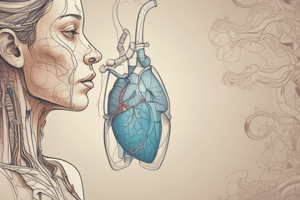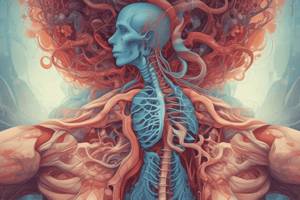Podcast
Questions and Answers
What is the primary function of Fick's Law in the respiratory system?
What is the primary function of Fick's Law in the respiratory system?
- To describe the diffusion of gases across membranes (correct)
- To explain the solubility and transport of gases in liquids
- To describe the total pressure of a gas mixture
- To monitor hemoglobin's oxygen saturation
What is the main form of carbon dioxide transportation in the blood?
What is the main form of carbon dioxide transportation in the blood?
- Dissolved in plasma
- As bicarbonate ions (correct)
- As oxyhemoglobin
- Chemically bound to hemoglobin
What is the role of hemoglobin in the respiratory system?
What is the role of hemoglobin in the respiratory system?
- To bind to oxygen in the lungs and release it in tissues (correct)
- To regulate the total pressure of a gas mixture
- To monitor the partial pressure of oxygen
- To facilitate the diffusion of gases across membranes
What is the primary factor that influences the binding and release of oxygen from hemoglobin?
What is the primary factor that influences the binding and release of oxygen from hemoglobin?
What is the result of the combination of Fick's Law, Dalton's Law, and Henry's Law?
What is the result of the combination of Fick's Law, Dalton's Law, and Henry's Law?
What is the importance of monitoring hemoglobin's oxygen saturation?
What is the importance of monitoring hemoglobin's oxygen saturation?
What is the primary mechanism of oxygen transportation in the blood?
What is the primary mechanism of oxygen transportation in the blood?
What is the role of Henry's Law in the respiratory system?
What is the role of Henry's Law in the respiratory system?
What is the primary function of the trachea, bronchi, and bronchioles?
What is the primary function of the trachea, bronchi, and bronchioles?
What is the role of the diaphragm and intercostal muscles in breathing?
What is the role of the diaphragm and intercostal muscles in breathing?
What is the shape of the cartilage in the trachea and why?
What is the shape of the cartilage in the trachea and why?
What would happen to the trachea without the C-shaped cartilage?
What would happen to the trachea without the C-shaped cartilage?
What is the role of type I alveolar cells in the respiratory system?
What is the role of type I alveolar cells in the respiratory system?
What is the main role of surfactant in the lungs?
What is the main role of surfactant in the lungs?
What is the consequence of alveolar collapse?
What is the consequence of alveolar collapse?
What is the role of alveolar macrophages in the respiratory system?
What is the role of alveolar macrophages in the respiratory system?
What is the primary function of surfactant in new-borns?
What is the primary function of surfactant in new-borns?
What is the main factor that governs the process of diffusion?
What is the main factor that governs the process of diffusion?
What is the outcome of a steeper concentration gradient in the process of diffusion?
What is the outcome of a steeper concentration gradient in the process of diffusion?
What is the primary role of external respiration?
What is the primary role of external respiration?
What is the physical law that drives pulmonary ventilation?
What is the physical law that drives pulmonary ventilation?
What is the effect of the diaphragm and intercostal muscles contracting during inhalation?
What is the effect of the diaphragm and intercostal muscles contracting during inhalation?
What is the outcome of the pressure gradient created during inhalation?
What is the outcome of the pressure gradient created during inhalation?
What is the primary role of internal respiration?
What is the primary role of internal respiration?
Study Notes
Gas Exchange and Transport
- The concentration and movement of O2 and CO2 between air, lungs, blood, and tissues are regulated by Fick's Law, Dalton's Law, and Henry's Law.
- Fick's Law describes the diffusion of gases across membranes.
- Dalton's Law states that the total pressure of a gas mixture is the sum of its partial pressures.
- Henry's Law explains the solubility and transport of gases in liquids.
Oxygen and Carbon Dioxide Transport
- Oxygen is primarily carried by haemoglobin in red blood cells, forming oxyhaemoglobin.
- The binding and release of oxygen are influenced by factors such as partial pressure of oxygen and pH.
- Carbon dioxide is transported in three forms: dissolved in plasma, chemically bound to haemoglobin, and as bicarbonate ions.
Importance of Haemoglobin
- Haemoglobin binds to oxygen in the lungs and releases it in tissues, ensuring oxygen reaches all cells.
- Haemoglobin increases the oxygen-carrying capacity of blood, and its affinity for oxygen allows efficient oxygen uptake and delivery.
Respiratory System Structure and Function
- The trachea, bronchi, and bronchioles transport air to the alveoli, where gas exchange occurs.
- The diaphragm and intercostal muscles facilitate breathing.
Role of the C-Shaped Cartilage in the Trachea
- The C-shaped cartilage in the trachea provides support and prevents the trachea from collapsing during breathing.
- The cartilage rings are C-shaped to allow flexibility and accommodate the movement of the oesophagus, which lies behind the trachea.
Roles of the Cells of the Respiratory Zone
- Type I alveolar cells facilitate gas exchange.
- Type II alveolar cells produce surfactant to prevent alveolar collapse.
- Alveolar macrophages protect against pathogens.
- Capillary endothelial cells aid in gas exchange with the bloodstream.
Role of Surfactant
- Surfactant is a substance produced by type II alveolar cells in the lungs.
- Its main role is to reduce surface tension in the alveoli, preventing their collapse during exhalation.
Factors that Govern Diffusion
- Concentration gradient
- Temperature
- Molecular size and weight
- Surface area
- Medium permeability
- Distance
Processes of Respiration
- External respiration: pulmonary ventilation (breathing) and gas exchange in the lungs, where oxygen enters the bloodstream and carbon dioxide is expelled.
- Internal respiration: oxygen transport in the blood to the body tissues, cellular respiration where oxygen is utilized to produce energy, and gas exchange at the tissue level where oxygen is delivered and carbon dioxide is removed.
Respiratory Mechanics
- Pulmonary ventilation, or the process of breathing, is driven by Boyle's law.
- According to Boyle's law, the pressure of a gas is inversely proportional to its volume.
Studying That Suits You
Use AI to generate personalized quizzes and flashcards to suit your learning preferences.
Description
Learn about the concentration and movement of oxygen and carbon dioxide between air, lungs, blood, and tissues, regulated by Fick's Law, Dalton's Law, and Henry's Law.




